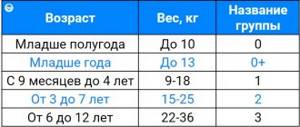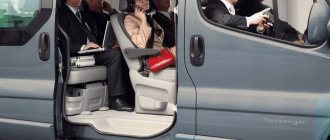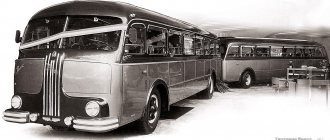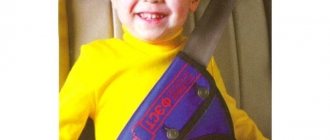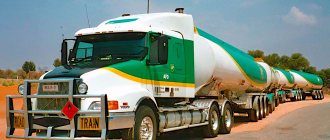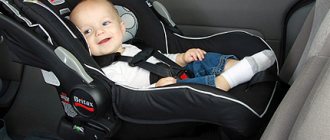Rules for transporting children in a car in 2021
The first fine for not having a car seat for a child, 500 rubles, was introduced in 2007. Since that time, it has increased several times, and by 2021 it amounted to 3,000 rubles. up to 100,000 rubles, depending on a number of accompanying circumstances.
Standards for the safe passage of children in vehicles were prescribed in the traffic rules back in 1993. According to them, the possibility of transporting a child in the back or front seat of a car was regulated. They established criteria under which standard seat belts could be used, or whether additional means were required.
Rules for the passage of children in motor vehicles place full responsibility for their observance on adults. According to them, there are separate standards for transporting a child in the rear or front car seat.
Children can ride in the front seat of a car if the following conditions are met:
- if a child is over twelve years old, weighs 36 kg or more, and is at least 150 cm tall, he can ride in the front seat of a car, fastened with regular car seat belts;
- If a child is under twelve years old, weighs less than 36 kg, and is not 150 cm tall, he can ride in the front using assistive safety devices (car seats and their equivalents).
Safe passage of children in the back seat of a car requires the following conditions:
- if the child is twelve years old, his weight and height have reached the required parameters (150 cm, 36 kg), he can ride in the back seat of a car, fastened with regular seat belts;
- If a child is under twelve years old, weighs less than 36 kg, and is not 150 cm tall, he can ride in the back seat of a car using additional safety equipment (child car seat and similar).
The use of auxiliary safety devices that are inappropriate for the weight, age and height of the child, according to the traffic rules, is perceived as a lack of necessary safety devices.
Transporting a child without a car seat, or with a device that is inappropriate for his age, height and weight, is punishable by penalties. The size of the fine depends on a number of factors and can range from 3 thousand rubles. up to 100 thousand rubles.
How much is the fine for a child seat in 2021?
There are several degrees of responsibility for failure to comply with the standards for the safe transportation of children in vehicles.
| The person who committed the violation | Penalties (RUB) |
| Individual – parents, relatives, acquaintances, etc. | 3 000 |
| Official - taxi driver, teacher, educator, etc. | 25 000 |
| Organization – educational institution, organization performing passenger transportation, etc. | 100 000 |
Individuals belonging to different groups may be subject to separate liability for violating the standards for the safe transportation of a child.
In the case of a trip in a taxi that is not suitable for transporting a child, the fine for driving without a child seat in the car will be paid by both the driver (25,000 rubles) and the passenger accompanying the child - a parent, relative (3,000 rubles) or a teacher, educator ( 25,000 rub.).
If there are clear signs of violation of the standards for the safe transportation of children, the organization providing transportation may be additionally held liable.
Fine for violating the rules for transporting children
Since the rules for transporting children in cars are now specifically stipulated, it is natural that there should also be liability for non-compliance with them. In particular, in Art. 12.23 of the Code of Administrative Offenses of the Russian Federation prescribes a fine of 3,000 rubles for violating the procedure for transporting a child.
According to this standard, the driver may be held liable not only for the absence of a car seat, but also for the use of non-standard products or violation of the order of their installation. The Code of Administrative Offenses does not yet provide for deprivation of rights for the violation in question.
Amendments to the traffic rules now also prohibit leaving a child under 7 years old alone in a car (unaccompanied by an adult). Such an offense will result in a fine of 500 rubles.
However, if the driver admits his guilt, he can pay a fine of half the amount. To do this, you have 20 days from the date of the traffic police decision. If you don’t make it in time, you will have to pay the entire amount in full.
Rules for transporting children in a car in 2021
The basic standards for the safe transportation of children are prescribed in the traffic rules (clause 22.9). Violation of the norms prescribed in the traffic rules falls under the jurisdiction of the Administrative Code of Russia, part 3, article 12.23.
If the child is under twelve years old, but has reached the height and weight required for safe use of standard car seat belts, the situation is regulated by the norms of the administrative code prescribed in Article 12.6. (Regulation on penalties for a passenger not wearing seat belts - 1000 rubles).
In the event of an accident that causes harm to the health of a child, the situation may be regulated by the provisions of Article 238 of the Criminal Code. The amount of penalties under this article can be up to 500 thousand rubles.
A child who is not restrained and not in a car seat cannot be the reason for fines if the car is not moving.
A child who is under twelve years old, but is taller than 150 cm and weighs more than 36 kg, fastened in the back seat with standard seat belts, does not violate the safety standards prescribed by the traffic rules.
If a traffic police inspector stops an ordinary driver who is transporting a small child in his car without a seat, then he faces liability under Article 12.23 of the Code of Administrative Offenses and a fine of 3,000 rubles.
It’s another matter if such a violation is committed by a taxi who is engaged in his activity professionally and has the appropriate permits and travels in a taxi car.
In this case, the driver may be charged under Article 238 of the Criminal Code of the Russian Federation - “Provision of services that do not meet the requirements for the safety of life or health of consumers.”
- Under the first part of this article, you can receive a fine of up to 300 thousand rubles , or restriction of freedom or even imprisonment for up to 2 years.
- According to the second part of the same article, if the case involved children under 6 years of age, or the consequences were the infliction of serious harm or the death of a person, the sanctions for the driver will be even tougher. The fine for a child without a car seat in a taxi is from 100 to 500 thousand rubles , or imprisonment for up to 6 years (!), with a fine of up to 500 thousand rubles.
- Part three of Article 238 of the Criminal Code of the Russian Federation is the most stringent and is applied if, for example, an accident results in the death of two or more persons. Sanction: up to 10 years in prison.
That is, if, for example, a taxi driver has an outstanding criminal record, and if he is caught violating Part 1 of Art. 238 of the Criminal Code of the Russian Federation (simply transporting a child without a seat), then the judge can easily send him to jail, according to the law.
Even worse, if an accident occurs (even if the taxi driver was not at fault, they drove into him) and it turns out that the taxi driver was transporting children with disabilities, and they, God forbid, were injured, the corresponding article of the Criminal Code will inevitably be applied to the driver.
Let's look at a few important facts about transporting all children:
1. If the design of the car (or one of its seats) does not provide seat belts, then in this car (on this seat) a child can be transported without a child seat and not fastened. However, this is not safe.
2. Previously, traffic regulations required that only child restraints that could be used to fasten a child using seat belts should be used in a car. However, modern child seats are fastened using the ISOFIX standard, which does not require the use of standard seat belts. The updated rules take this issue into account. Now drivers using seats with the ISOFIX system do not have to worry about traffic police fines.
3. Previously, paragraph 22.9 dealt with vehicles, which included not only cars, but also, for example, mopeds and tractors. Those. Both mopeds and tractors had to install child restraints when transporting children. The updated rules only apply to passenger cars and truck cabs. In other vehicles, child restraints are not required.
Is it possible to ride in a taxi without a child seat?
No, a taxi is the same car, and it can also get into an accident. In taxi ordering applications you can order a car with a child seat. For example, Citymobil and Yandex.Taxi make it possible to select it according to the child’s weight.
This is what Citymobil's choice looks like
Yandex.Taxi also has a choice of seat type
Taxi fine if child is without a seat. If a traffic police officer stops a taxi and a child is riding in it without a special seat, the director of the taxi company will receive a fine of 100,000 rubles. If people were injured or killed as a result of the taxi ride, the director will receive a more serious punishment. This is a fine of up to 500,000 rubles or up to 6 years in prison with a fine of up to 500,000 rubles.
Changes to the rules for transporting children in a car in questions and answers
The fine for not having a child seat varies depending on who committed the offense:
| Responsible person | Amount of fine in rubles |
| Driver (Parents, relatives) | 3 000 |
| Officials – educators, teachers, taxi drivers | 25 000 |
| Legal entities – school, taxi company | 100 000 |
It is possible to pay the fine with a 50% discount within 20 days from the date of delivery of the decision to the citizen.
Most often, difficulties with the law on child seats arise in large families. One car can comfortably accommodate two, rarely three, seats, but without them all four or even five children could fit in the back seat.
Another drawback is the imposition of fines on taxi drivers. Sometimes parents deliberately do not warn that there will be a child in the cabin, so as not to increase the cost of the trip. When an inspector stops a car, the blame falls on the taxi driver. In extreme cases, the fine for parents will be 3,000 rubles, and for the driver – 25,000.
Types of car seats for children on the Russian market:
| Child's age | Restraint type | Weight in kg. | Group (class) car seats |
| from birth to 1 year | Carrying or “cradle”. They are installed in the car in one of two positions: horizontal, in which the child can sleep in the car, vertical, in which the baby is held using a special belt. | to 10 | 0 |
| up to 1.5 years. Can be used for children from the first day of life. | Armchair. The child in it is in a “reclining” state. The device can be positioned either with your back or facing the direction of travel. | up to 13 | 0+ |
| from 1 year to 4 years | Armchair. Installation can only be done in the direction of travel of the vehicle. The child is secured using durable, five-point harnesses. | 9-18 | 1 |
| from 3 to 7 years | Armchair. Standard seat belt. The chair has an adjustable backrest that can be adjusted to the height of the child. | 15-25 | 2 |
| from 7 to 12 years | Seat without backrest. The child is held in place by an additional seat belt. | up to 36 | 3 |
Each type of seat is used only for children of a certain age. Some car seats, for example, categories 0 and 0+, are adjustable depending on the child’s height and weight, but from 1.5 years old it is necessary to purchase a larger seat.
When purchasing a child seat for your car, there are a few things to consider:
- Type of belt fastening. There are two types of fastenings: standard and improved - ISOFIX. Both options are suitable for passing a traffic police check, but the ISOFIX system is more reliable in the event of an accident.
- Seat belts on the seat. Small children must be secured in the bassinet. Special built-in belts are designed for this - three- or five-point. Fixing with a safety table is also possible. The best option is a five-point harness.
- Chair frame. The most durable and reliable is the aluminum frame, as opposed to plastic.
- You should choose those models that are equipped with a durable, large headrest and sides.
- Preference should be given to covers made of cotton fabric, as they are better suited to the baby's skin and do not irritate it.
- By car and driver
- By resolution number
Popular QUESTIONS and ANSWERS about child car seats
Home / Good to know / Popular QUESTIONS and ANSWERS about child car seats
CHILDREN IN THE CAR
At what age can you put a child in a car seat?
From birth. Babies are the most fragile passengers. Neither a mother's hands nor a portable cradle from a stroller can provide the child with the necessary safety. The baby will be safe and sound in a special car seat for infants, groups , , 0+/1 . The car seat must be properly secured and positioned facing the rear of the vehicle. This special infant car seat provides the best protection for your child.
What should you pay attention to when choosing a child seat? First of all, the seat must be appropriate for your child's weight and height and suitable for your vehicle. Secondly, the seat must have a stamp on it stating that it meets the required safety standards. Pay attention to how it performs in crash tests.
In which part of the car can a child car seat be installed? Depends on several reasons. Many people prefer that the child be close to the driver's seat, that is, in the front passenger seat. In accordance with traffic regulations, transportation of children under 12 years of age in vehicles equipped with seat belts in the front seat is permitted only with the use of a child restraint system. But ! Do not place a child in the front seat when the airbag is activated. If the airbag deploys, the child may be seriously injured or even killed. Therefore, if this seat is equipped with an airbag, the car seat must be placed in the rear seat of the car. Some cars are equipped with a button to temporarily turn off the airbag.
Which car seat is the safest? The safest place in the car is the middle rear. Therefore, it is recommended, if possible, to install child car seats in the middle seat of the rear row of seats (provided that the car is five-seater), or in the middle seat of the middle row of seats (if the car is seven-seater). Remember that a child should never use a front seat that is equipped with an airbag and unless the airbag has been disabled by a professional.
Do side airbags pose a risk to child passengers in a vehicle? No.
What should you pay attention to when purchasing a used car seat? Do not buy this type of seat unless it is relatively new. Make sure that it is in full working order, that its design complies with safety standards, that it has all fasteners and installation instructions. You cannot buy a car seat that has been in an accident, as its frame may be deformed. In addition, the design of child seats has changed a lot in a short period of time, the new seats are safer than the old ones.
What is Isofix? Standardized car seat anchorage system for infants and children. The essence of the Isofix system is that the seat is attached not with a standard car belt, as usual, but with special “anchors” that are an integral part of the car.
How to properly install a child car seat? Follow the instructions for installing the car seat. Chairs with the Isofix fastening system are easy to install. Installing other seat systems is not as easy. Be sure to read the manufacturer's instructions! If you have any problems, please contact your dealer for advice. Remember that improperly installed car seats (as well as improperly restraining children) can cause serious injury in the event of an accident.
Is it possible to sit a child on an adult’s lap when traveling in a car? No. Children should never be allowed to sit on an adult's lap in a car. In a collision, even at low speed, the weight of passengers increases several times. In such a situation, the passenger holding the child in his arms will squeeze him between himself and the back of the front seat, leaning on his weight, which has increased to half a ton, or even more. Or, having slipped out of your hands, the child himself will receive life-threatening injuries. Each child should have his own place and suitable type of protection.
BABIES IN THE CAR.
What should you pay attention to when choosing a car seat for an infant? For infants, car seats of groups “0” and “0+” are used. Group 0 car seats are infant carriers with internal straps that secure the child. They must comply with ECE R44/03 (or 44/04). For children from birth, it is better to use car seats of group 0+ (for children weighing up to 13 kg). They provide a higher level of child safety and are installed facing the direction of travel. Note: It is not recommended to carry newborn children for long periods of time, since car seats in this group (0+) do not provide a completely horizontal resting position for safety reasons. In order not to burden the baby’s fragile spine, it is necessary to make stops, giving the child a break from the car seat.
Is it safe to use a carrycot as an alternative to a stroller with attachment straps? No. The cradle will be secured, but the baby in it will not.
How long should an infant seat be used? As long as possible - until the baby learns to sit correctly, up to approximately nine months. When his head reaches the top of the seat, it is time to move him to a larger seat (group 0+/1 or 1), but still facing the direction of travel of the car.
ABOUT REVERSE-FRONT CHILD CAR How long should children use rear-facing car seats? Young children should use rear-facing car seats for as long as possible. It is recommended that children continue to use rear-facing car seats until they are 3-5 years old. The fact that the child will not be able to stretch his legs to their full length does not harm his safety. Why is this so important? Young children's necks are not strong enough to cope with the force of their head being thrown back and then thrown forward when the front of a car hits them. The neck is subjected to a lot of stress if the child is facing the direction of travel of the car. In a rear-facing seat, the entire weight of the load falls on the child’s back, and the head is not thrown sharply forward. The forces acting upon impact from the rear of the vehicle are usually weaker.
A child should be transferred to a forward-facing car seat only when his weight exceeds the permissible limits for this type of seat or when his head is higher than the back of the seat.
What should I do if my child does not want to use a child car seat? Take a break. Place the new seat at home and allow your child to first get used to it in familiar conditions.
What to do if a child falls asleep with his head tilted to one side? If it does not cause any particular inconvenience to the child, there is no reason to worry. If you are still worried, stop the car and prop your child's head up with a pillow. There are also special travel pillows. Typically, chairs of groups 0+/1 and 1 have several positions for sleeping and waking, in other words, it is convenient if the chair has an adjustable backrest.
ABOUT CHILD CAR SEATS INSTALLED IN THE DIRECTION OF VEHICLE MOVEMENT
Does a booster seat without a back protect no worse than car seats of the same group with a back? No, the car seat/backrest combination is the best protection for children. The use of a booster is permissible if the child’s height is 120 cm and above. In addition, the booster must have a special strap with a buckle to adjust and secure the standard belt on the child’s shoulder.
How should the belt be positioned? The diagonal part of the belt should go over the shoulder, close to the child's neck. Don't worry if you feel like the belt is too close to your neck. A more risky option is when the belt is located at the edge of the shoulder. In an accident, the child may even be thrown over the seat belt. For the same reason, the belt should never pass under a child's arm. The lap portion of the belt should go over your hips and upper legs. The belt must be positioned correctly - exactly along the ridges on both sides of the booster car seat. Otherwise, it may slip onto your stomach and cause internal injuries in the event of an accident. Both parts of the belt must be well tensioned. Adjust the seat belt well when fastening your child.
Is it possible to place a child on a regular pillow instead of a specialized booster? No. A regular pillow is too soft. In the event of an accident, it may slide forward or become flat and the child may slip out from under the belt. In addition, a regular airbag does not provide proper seat belt placement.
How tall does a child have to be to sit in a car seat with an airbag disabled? 140 cm
What should I do if my child refuses to sit in a car seat? You must persuade him.
When can a child stop using a car seat? With a height of 150 cm and a weight of 36 kg. If the child already weighs 36 kg but is less than 150 cm tall, he should continue to use a car seat or booster.
Rules for transporting children in a car
For most parents, nothing changes - the rules for transporting a child in a family car or in a taxi in 2021 remain the same. The changes affect the transportation of groups of children by bus - the rules are really becoming stricter for organizers of such trips.
Parents should be aware of these changes, at least briefly, just to monitor the safety of their children when sending them to children's camps, on school excursions, etc.
After 12 years, children can already be transported without using a car seat, but only if the child is taller than 1.5 meters. If his height does not exceed the specified mark, then it is worth using holding devices. Also, from the age of 12, a child can ride in the front seat without special restraints , fastened only with adult seat belts.
If a child is traveling in a car with his parents, in 2021 the classic transportation rules apply. The minor must be in a car seat that is suitable for his height and age. Transporting children under 12 years of age in the front seat of a car is not prohibited if special restraints are used. Parents must select the appropriate device themselves.
And for children over 7 but under 12 years old there are still some restrictions. They can also sit in the back row simply by fastening with regular seat belts. But simply transporting them in the front seat is still prohibited. If a child rides in the front, he must be in a car seat. In this case, the driver needs to turn off the passenger airbag: in the event of an accident, it will only injure the child.
All children under 7 years old will only have to ride in a car in a car seat. From a legal point of view, they cannot be fastened with regular belts, even if they are taller than 1.5 meters.
The location of the seat does not matter: the child seat must be in both the front and back rows. And it should be selected taking into account the height and weight of the child.
Types of child restraints
Manufacturers divide child seats according to the height and weight of the child. There are four groups in total:
- for a child up to one year old,
- up to seven years old,
- from seven to twelve years old,
- after twelve years.
From left to right: cradle up to twelve months, chairs up to seven years and from seven to twelve years
This booster is for children over seven years old. It is designed so that the child sits higher - so the straps will lie on the chest and not on the neck. It costs less than a seat, but the UN is against placing children under 125 cm and weighing less than 22 kg on a booster.
New rules for transporting children in cars in 2021
No child seat is suitable for infants, but you cannot hold them in your hands during the trip. Both options are extremely unsafe. The chair will not work because the baby’s muscles and spine are not yet fully developed: in a sitting position, he can get injured even during sudden braking. Simply holding him in your arms is also dangerous: during a collision, an adult simply will not be able to hold him.
For infants, special infant carriers are sold in which they will remain in a horizontal position at all times. This reduces the risk of injury during braking and accidents. This car seat can take up two seats. But some models can be installed in the front seat; the law does not prohibit this.
| Child's age | Front seat | Backseat |
| Up to 1 year | Cradle | Cradle |
| From 1 year to 7 years | Baby chair | Baby chair |
| From 7 to 12 years | Baby chair | Standard belts |
| More than 12 years | Standard belts | Standard belts |
The law does not establish any restrictions on the installation location of a child seat. The only condition when transporting a child in a child seat in the front seat is the absence or deactivation of an airbag.
As for safety, the central seat in the back row is considered the most secure. This is where it is best to install a child seat in order to protect the child as much as possible in case of accidents.
- Car loans
- All about OSAGO
- All about CASCO
- Car insurance
- Car taxes
- Road accident - what to do?
- All about carsharing
- Fines
- Registration actions
- Communication with the traffic police
- To help drivers
Minor passengers are allowed to be transported in cars and truck cabins, subject to certain rules. It is prohibited to transport children under 12 years of age on the back seat of a scooter or motorcycle. Now they are allowed to be transported in passenger cars if the seat is equipped with a special seat or cradle. The booster and triangular configuration adapter are not suitable for this.
Recommendations for the correct transportation of infants in vehicles are prescribed in the Russian Federation Traffic Regulations, in paragraph 22.9. The latest version states that it is not allowed to transport newborns without restraints. There are no detailed explanations, but this implies the use of a cradle, LDC, stroller, car seat, taking into account the age and weight of the passenger.
If the question arises whether it is possible to transport a small child in your arms, it is worth reading clause 22.9 of the Russian Traffic Regulations, as amended. The rules here are the same as for children under one year of age, provided that there is a device that matches the weight and age of the baby. Passengers under 7 years of age and older are allowed to travel if standard seat belts or a system with the Isofix mark -1 are provided.
The law on transporting children in a car states: it is permissible to transport a child in the front seat if there is a standard restraint element. If a small passenger is in the back seat of a car or truck cab, he must be fastened with seat belts or be protected by a securing device.
It is not necessary to buy a separate seat - you can make it yourself for free, in compliance with the requirements of traffic rules for transporting children, depending on the year of birth. The created accessory will protect the little passenger if the design meets all the necessary requirements.
If you have doubts about a homemade device, it is better to buy a factory analogue. The child can be involved in choosing a child car seat. This helps to purchase the most comfortable model, taking into account anthropometric data. You should not buy an accessory “for growth”. The operation of such products does not give the desired effect. Among the main selection criteria are the types of fastenings and methods of fixation.
Without special devices, transporting children in a car in the front seat is allowed from 12 years of age. The child's height must be at least 1.5 meters. For safety, it is necessary to use standard securing straps, adjusting them accordingly.
Airbag deactivation
Most new modern cars are equipped with a passenger airbag located opposite the front passenger seat. At the same time, it is technically possible to turn off this pillow when transporting a child.
In this regard, drivers have a question: is it always necessary to turn off the airbag when installing a child seat in the front seat? Or only when the seat is installed rear-facing?
Getting an answer to this question is quite easy. You should refer to your vehicle's owner's manual and look for the section on transporting children.
In the process of writing this article, I turned to the operating manual for my car and found the following information there:
When installing a child seat on the front passenger seat in which the child sits backwards, the front passenger's front airbag must be deactivated.
Moreover, the information is duplicated on different pages of the book at least 3 times. However, nothing is said about the fact that the airbag needs to be turned off when installing the seat in the direction of travel.
Those. In my car, the airbag only needs to be turned off when the child is sitting in the seat backwards.
I recommend studying your car's manual and finding similar information there. Please note that information may vary! In some cars, the airbag must be turned off when the seat is installed in a rear-facing position, as well as when installed in a forward-facing position.
Fine for transporting children without a seat in a car in 2021
The table shows the official standards for children's car safety devices, in accordance with the law and the requirements of the State Traffic Safety Inspectorate.
Law enforcement officials can impose fines not only for the absence of a child seat, but also for improper installation of the accessory, or violation of the norms for accompanying children at night. The seat is not allowed to be installed upside down. This contributes to serious injury or death as a result of an accident or emergency stop.
Children under 7 years old can only be transported in a car seat . It doesn't matter whether they ride in the front seat or in the back. In addition, according to current requirements, children under 7 years of age are prohibited from being left unattended in the car - there must be someone of age nearby.
Rules for transporting children from 7 to 11 years old depend on their location in the car:
- in the front seat - only in a car seat;
- in the back seat - you can use both a car seat and standard car seat belts.
- Fine for transporting a child without a car seat 2021 - 10/29/2020
- Rules for transporting children in a car 2021 - 07/17/2019
- Rules for transporting children in 2021 - 02/25/2018
- Rules for transporting children - latest news (04/14/2016) - 04/14/2016
- Rules for transporting children 2021 - 01/12/2016
- Changes for drivers from October 26, 2021 - 10/25/2020
- Is a "Spikes" sign necessary in winter 2021? — 23/10/2020
- Fines for free travel on toll roads were approved in the first reading - 10/23/2020
- Many drivers will be able to avoid trial for fines - 10/22/2020
- How to transfer diagnostic card data to the insurance company? — 22/10/2020
- Traffic rules changes from 2021 - 12/27/2018
- License exam 2021: 14 important changes - 12/25/2019
- Traffic police fines from January 1, 2021 - 11/16/2020
- Will it be possible to get a license from 16 or 17 years old in 2021? — 01/05/2021
- Amendments to the traffic police exam have been postponed from October 1, 2021 - 05/23/2020
Child car seats may not be used if the child is over 12 years old. Thus, it is permissible to replace the car seat with other restraint devices: special pillows, boosters, and so on, while securing the baby with standard belts.
It is prohibited to transport children in your arms, in weight, in a cradle or seat from a regular stroller, using regular pillows, since these methods do not provide the proper level of safety.
The installation of child restraints is permissible:
- In the front seat of the car.
- In the back seat.
Transporting children in the front seat is permitted:
- for babies aged 0-1.5 years using a car seat, which is installed perpendicular to the seat or with the back to the direction of travel of the car. In this case, you need to turn off the airbag
- children of other ages using car seats. Installation of the restraining device is carried out by facing the direction of travel
Transporting children in the back seat of a vehicle is permissible:
- for infants aged 0 - 0.15 years in a car seat, installed with its back to the direction of travel
- for other children using car seats (up to 7) or other devices and regular seat belts (7-12 years old)
Child in a car
Most often, parents transport their children in private cars. Please note that category B includes not only passenger cars, but also small trucks. For them, the transportation rules are different and they will be discussed below.
| Age | Conditions of transportation |
| from 0 to 11 years | Only using a child restraint |
| from 11 to 18 years old | Using standard seat belts |
What devices can be used to transport children
Rules for transporting children according to traffic rules in a car in 2021
You can ride in the front seat from birth, but you must follow the prescribed rules.
This is a special device for babies under 1 year of age, designed for different categories - from 10 kg and above. The child is placed horizontally and secured with straps.
If the car seat is placed on the front passenger seat, then it is imperative that the baby’s back is facing the windshield, that is, with its back to the traffic. This is an important requirement. Such a trip is guaranteed to be safe for him. In case of sudden braking, nothing will threaten him.
Children under seven years old can be in a car seat with standard belts and the ISOFIX system. In simple terms, the child must be placed in a car seat or restraint device with a belt fastened at the same time.
Up to 7 years only in a car seat!
From 7 to 11 years
Children from 7 to 11 can sit in a seat with special ISOFIX fastenings or be buckled up. They can also be located in front, but only with the use of a child restraint system. It is important that the device matches parameters such as height and weight. Failure to comply with this condition will result in a fine. In the event of a minor collision with another car, the airbag may deploy and cause injury to the passenger - it should be turned off. If the airbag does not turn off, then it is best to give the child a seat in the rear passenger seat.
Children from 7 to 11 are in the front seat only in a car seat; in the back seat they can be fastened with seat belts.
In what cases are parents most often fined? There may be two options here:
- the child should be in a child care system, but is without it;
- not fastened.
If a passenger requires a child restraint system, but does not have one, the owner of the car will be fined 3,000 rubles. When it is permissible for a child to be without a child restraint (over 11 years old), but he is not wearing a seat belt, a fine of 1000 rubles.
The chair is installed as follows:
- move the front seat so that it is not in the way;
- we place the child control system in the right place;
- we pull the standard seat belt through the slots of the device;
- We check the strength of the installation and fastenings;
- We make sure that the belts do not squeeze, do not hang down or are not in the child’s neck area.
Installation of the equipment will not take much time, but at the same time guarantees the safety of the passenger. A car seat should be purchased with a child so that it is suitable for height and weight; you should not make a purchase “for show.”
Drivers often have questions related to the rules for transporting children in a private car. We will try to answer the most common ones:
- Where is the best (safest) place to place the car seat? – The safest place is considered to be the central part of the rear passenger sofa. You can also place a car seat with a newborn on it.
- Do you need to take documents for child care with you? A traffic police officer has the right to request a document for the device to be checked in order to ensure its safety and compliance with established rules and regulations. We recommend storing it in your vehicle.
To avoid problems with the law, you should strictly comply with them. Remember that they relate to preserving the health and life of the child, so do not neglect them.
What the law says
How to properly secure a car seat in a car
According to the legislation of the Russian Federation, in the country, children aged 0 to 12 years old must be transported in a special restraint device that is attached to the car seat. But since the height and weight of a toddler are individual indicators, the law specifies: a car seat is used until the child reaches 36 kg and 140 cm.
Children are constantly growing, so over time you will have to change from one car seat to another. In this case, you need to rely on the following points:
- the safety belt exit points of the device are below the level of the baby’s shoulders;
- the head rises 1/3 above the upper border of the device.
The car seat ensures the safety of the child during the trip
Types of child car seats
Russian GOST supports the global classification of car seats according to the weight and age of the small passenger. The basis for choosing a device is the baby’s body weight.
Groups of car seats depending on the age and weight (in kilograms) of the baby - table
| Group name* | Weight | Approximate age | Installation method |
| Group 0 | 0–10 kg | From birth to 6 months. | Sideways to the direction of travel. |
| Group 0+ | 0–13 kg | From birth to 1 year. | Facing against traffic. |
| Group 1 | 9–18 kg | From 9 months to 4 years. | Face in the direction of travel or against, if the baby is heavier than 9 kg, but younger than 9 months. |
| Group 2 | 15–25 kg | From 3 to 7 years. | Face in the direction of travel. |
| Group 3 | 22–36 kg | From 6 to 12 years. | |
| *In addition to individual age groups, car seat manufacturers also produce mixed ones, for example, 0+/1, 2/3, 1/2/3. Interestingly, the category 0+/1 device can be installed both in the direction of travel of the car and against it, depending on the age and weight of the child. |
Types of car seats that can be used by drivers - photo gallery
Some features of attaching a car seat in a car
To the question “How many options are there for attaching a car seat?” we can confidently answer: four. The device is allowed to be placed:
- in the back seat on the right - a fairly safe position, given that the sidewalk is always on the right, but the driver will have to install an additional rear-view mirror, since it will be difficult for him to see the toddler in the standard one;
- in the back seat on the left - it is considered safe for cars in which the steering wheel is located on the left, since during a collision the driver instinctively turns it to the left side, deflecting the impact from himself;
- in the back seat in the center - the safest installation method, since the baby ends up in “free space” both in a collision from the right and in a collision from the left, but not all car models allow you to secure the seat in the center;
- in the front passenger seat - makes it possible to entertain, feed and control all the actions of the little one in a traffic jam, but is unsafe, since the seat next to the driver is the most vulnerable in an accident.
At what age can a child ride in a car without a child seat?
| Violation | Article of the Code of Administrative Offenses of the Russian Federation | Punishment |
| Absence of identification signs “Transportation of children” or “Speed limit” on a bus transporting children | Part 1 Art. 12.5 Code of Administrative Offenses of the Russian Federation | warning or 500 rub. fine |
| “Children in the car” sticker obstructs the driver’s view | Part 1 Art. 12.5 Code of Administrative Offenses of the Russian Federation | warning or 500 rub. fine |
| Violation of the rules for transporting children (carriage of a child under 12 years old in the front seat of a car without a car seat, in the back seat of a motorcycle, etc.) | Part 3 Art. 12.23 Code of Administrative Offenses | Fine 3000 rubles. — for the driver; 25,000 rub. - for officials; 100,000 rub. - for legal entities. |
| Violation of the rules for the organized transportation of children from 23.00 to 6.00. | Part 5 Art. 12.23 Code of Administrative Offenses of the Russian Federation | for the driver - 5000 rubles. fine or deprivation of driving license for 4 - 6 months; for officials - 50,000 rubles; for legal entities - 200,000 rubles. |
| Violation of the requirements for the organized transportation of children to buses, drivers or documents | Part 4 Art. 12.23 Code of Administrative Offenses of the Russian Federation | Fine 3000 rubles. — for the driver; 25,000 rub. - for officials; 100,000 rub. - for legal entities. |
| Violation of other requirements for organized transportation of children | part 6 art. 12.23 Code of Administrative Offenses of the Russian Federation | Fine 25,000 rubles. - for officials; 100,000 rub. - for legal entities. |
The rules for transporting children under 12 years old from January 1, 2021 remain the same as last year.
When transporting a child under 12 years of age in a car that is equipped with seat belts, it is necessary to use child restraint systems or other devices that allow the child to be fastened with adult seat belts.” Transportation of children is permitted provided that their safety is ensured, taking into account the design features of the vehicle. Transportation of children under 12 years of age in vehicles equipped with seat belts must be carried out using child restraints appropriate for the weight and height of the child, or other means that allow the child to be fastened using seat belts provided for by the design of the vehicle, and in the front seat passenger car - only with the use of child restraints."
clause 22.9 of the traffic rules
Thus, based on traffic regulations, it is permitted to transport children under 12 years of age in a car equipped with seat belts:
- in child restraint seats or infant carriers;
- using booster seats;
- other means that allow the child to fasten with adult seat belts (FEST adapter)
Changes have been made to clause 12.8 of the traffic rules regarding the prohibition of leaving children under 7 years old in a car without adult supervision. In this case, the time during which personal transport is stopped is important. If no more than 5 minutes, then you can leave the child alone.
Violation of this clause entails a fine on the driver in the amount of 2.5 thousand rubles for Moscow and St. Petersburg and 500 rubles for other regions.
What is meant by the term “special restraint device”? It can be either a car seat corresponding to the child’s age and weight category, or a booster. A child car seat for children under 7 years of age must be equipped with seat belts. Older children can be secured with standard seat belts and additionally use a booster. When placing a small passenger in the front seat, special securing devices are required.
When installing a car seat in the front seat, the airbag must be turned off.
Newborn children can travel in vehicles only in car bassinets or special-type baby carriers. Such devices are designed for a child up to 12 months old and a maximum weight of up to 13 kg. They are usually labeled category 0 or 0+.
Traveling in a car with a child from one to 7 years old (or in the cabin of a truck) is possible using car seats of categories 1,2 or 3, depending on the height and weight of the child. When fixing the seat, standard seat belts or the ISOFIX system can be used. The safety and security of the child must be ensured by its own soft belts built into the structure of the car seat.
Rules for installing a child seat in a car
To protect your child, it is important to install the car seat correctly. The standards in accordance with which the restraint device is placed are not regulated by law. Clause 22.9 of the Russian Traffic Regulations only mentions that the seat must correspond to the age, height and weight of the child.
Transporting minors in restraints in the front seat is not prohibited in 2021. However, the airbag must be disabled. If it is activated, it can cause significant harm to the child. When a passenger over 12 years of age is carried in the front seat, the airbag must be turned on.
The most preferred place to install a child car seat is the center rear seat. Statistics show that this is the safest position in an accident.
Experts advise involving a minor in choosing a car seat. He should feel comfortable in the restraint. Buying a car seat for growth is considered inappropriate. Such a device is not capable of providing the necessary protective effect.
The height and weight of the child must be taken into account. The methods of securing the car seat are also taken into account. Clause 22.9 of the Russian Traffic Regulations only mentions that the seat must correspond to the age, height and weight of the child. However, there is a classification of child car seat markings. To make the right choice, the category mark from the table should be looked for on the car seat when purchasing.
| Category | Child's age | Weight Requirements | Description |
| 0 | Up to a year | 0-10 kg | A minor is placed in a cradle in a horizontal position. A belt is used for fixation. It should be wide. The device passes through the baby's stomach. If the device is used folded, it is secured using a three-point belt. |
| 0+ | Up to 1.5 years | 0-15 kg | The child is in a car seat in a reclining position. If required, it is permissible to place the device backwards relative to the movement. |
| 1 | 1-4 years | 9-18 kg | The child is placed in a car seat while sitting. Five-point harnesses are used. This is the main fixing element. |
| 2 | 3-7 years | 15-25 kg | The category differs from other children's car seats by the presence of the ability to adjust the height of the backrest. The device is secured using belts present in the car. With their help, the minor is also recorded. |
| 3 | 7-12 years | 22-36 kg | The devices have a top strap limiter. The backrest can be detached. The need for action arises if the child grows out of the car seat. |
Classification of child restraint systems
For each child’s age, as well as his height and weight, various child restraint devices have been developed and produced:
- Group 0 – car cradle. Suitable for newborns and children aged 6 months. Has a weight limit of up to 10 kilograms. The design feature is a curved stock with an additional fixing head collar.
- Group 0+. Also presented as a car cradle, with a permissible weight of 13 kg. Age – up to one year.
- Group 1. This group includes more familiar car seats. This device can be used for up to 4 years. The maximum permitted weight of a child is 18 kg.
- Group 2. This includes child car seats designed for loads from 15 to 25 kilograms. Age group – up to 7 years.
- Group 3. The latest group designated by the world classifier today. The age of use of such chairs is from 7 to 12 years; maximum weight – 36 kg.
The last third group includes an additional year of use (up to 12 years). This need is due to the individual characteristics of the pace of development of children.
